 |
The Atlantic City Aquarium's seventeen aquarium tanks and over 30,000 gallons of sea water bring the marine environment to Gardner's Basin.
Tanks
Please note:
The fish and sea animals contained in the aquariums will change as some die off and other specimens are added. The species noted here are typical of what will be included in the aquariums, but should not be considered a comprehensive or exact listing.
Fish of the Mid-Atlantic Ocean:
This 25,000-gallon tank is filled with many animals that make New Jersey waters their home. These include Nurse Sharks, Lookdowns, Permits, Surgeons, Sea Robins, Flounder, and Black Drums. And don't forget about Groman, our very own Loggerhead Sea Turtle!
|
|
|
|
|
"Groman"
"Groman" is a 100 pounds Loggerhead Turtle. Loggerhead turtles live in the deep sea, but nests and hibernates in local estuaries and beaches. They can weigh as much as 350 pounds. Like other marine turtles they are on the list of threatened species due largely to pollution, development in and around their nesting grounds and the incidence of drowning in fishing nets.
back to top
|
 |
|
The Coral Reef: 1100 gallons
Coral varieties include:
This tank is a constantly growing exhibit, showcasing the many animals (That's right, they are actually animals) that make up the Coral and Anemone families. You can see Leather, Velvet, Plate, Frogspawn, Bubble, Button, and Mushroom Corals. There are also many other animals present, including several Giant Clams. Although they're only babies, Giant Clams can grow to weight up to 700 pounds!
back to top
|
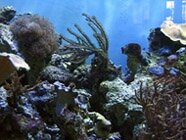 |
|
|
Seahorses: 300 gallons
Tank includes:
This 300-gallon tank is home to much more than just the curious Sea Horses, but represents a whole tidal community. These strange fish share their home with Pipefish (Their cousins), Sea Stars, Sea Cucumbers, Snails, Hermit Crabs, and Soft Coral.
back to top
|
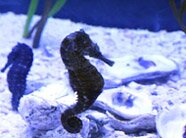 |
|
Touch Tank: 750 gallons
Touch Tank includes:
green, horseshoe, hermit, and spider crabs, green and purple sea urchins, forbes seastar, common periwinkle, channel and knobbed whelk, horse and blue mussels, common shore shrimp.
back to top
|
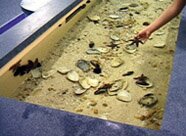 |
|
|
Fish Of The Indo-Pacific
A 1,500-gallon tank filled with reef denizens from the Indian and Pacific Oceans. Here you can find Yellow Tangs, Convict Tangs, Damselfish, Wrasse, and even a Pufferfish!
back to top
|
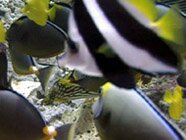 |
| |
|
|
|
|
|
Live Moon Jelly Fish:
Known as Aurelia, these Sea Jellies have flattened, transparent bells bearing 4 horseshoe-shaped gonads. They feed off of plankton, stinging them with small barbs called nematocysts. Not to worry though, unlike their larger cousins, their stingers are too small to pierce our skin.
back to top
|
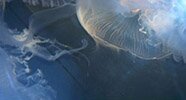 |
|
|
Giant Moray Eels:
Although thought of mostly as tropical animals, these Eels can be found off of New Jersey . Our Eel, Flotsam, is just over 4 feet long and weighs in at a little over 50 pounds. If you think that's big, they can actually grow to be up to 10 feet long!
back to top
|
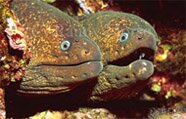 |
|
|
Mullica River Tank
This freshwater tank is typical of local cedar-water tributaries of the Pine Barrens (Stained brown from the tannins released by rotting vegetation), and houses a Spotted Turtle and freshwater fish such as the Black-Finned Sunfish and Catfish.
back to top
|
|
|
|
Terrapin Tank
Typical of the local estuarine environment, the water in this tank is brackish, meaning that it is a mix of fresh and salt water. Fish such as Perch and Killifish are able to live in both, as does the Diamondback Terrapin, an endangered species of turtle thankfully still common to New Jersey.
back to top
|
|
|
|
Tropical Rainforest
The Tropical Rainforest Exhibit features animals that are a cross section of species that inhabit tropical forests around the world, such as Fire Salamanders from North America and Europe; Flap Neck Chameleons, Tanzanian Giant Millipedes, and an Amani Forest Tree Frog from Africa; Gold Dust Geckos and Hissing Cockroaches from Madagascar; Red-Eyed tree frogs from South America; and Fire Belly Toads, Gold Tree Frogs, a Crested Gecko, and a Giant Vorax Gecko which collectively are found throughout Asia, down through Indonesia and into North Western Australia. The furnishings inside the enclosure also represent plants and other materials from the forests of nations around the globe. The environment in the enclosure is kept from 75 to 90 degrees with nearly 100% humidity, as would be conditions in most of the world's tropical rainforests. In the future, more exciting and truly exotic animals will be added, ultimately expanding the range of the forests represented to include every continent on which tropical rainforests exist.
back to top
|
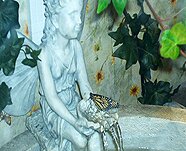 |
|
|
Bearded Dragons
Bearded Dragons live in the harsh deserts of central Australia, where they eat virtually anything available (Both plant and animal). They get their name from their habit of flattening their bodies, opening their mouths, and puffing out the spiky skin around their necks. Although ours are still small, they are growing rapidly, and may eventually reach a length of 2 feet.
back to top
|
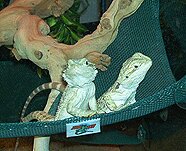 |
| |
|
 |